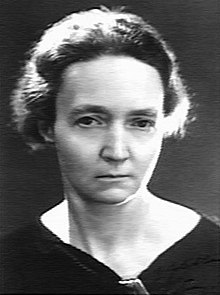Irène Curie
| Irène Joliot-Curie | |
|---|---|
 |
|
| Born |
Irène Curie 12 September 1897 Paris, France |
| Died | 17 March 1956 (aged 58) Paris, France |
| Cause of death | Leukaemia |
| Nationality | French |
| Alma mater | University of Paris |
| Spouse(s) | Frédéric Joliot-Curie (m. 1926) |
| Children | |
| Awards | Nobel Prize for Chemistry (1935) |
| Scientific career | |
| Fields | Chemistry |
| Institutions | |
| Doctoral advisor | Paul Langevin |
| Doctoral students | her children (see above) |
Irène Joliot-Curie (French: [iʁɛn ʒoljokyʁi]; 12 September 1897 – 17 March 1956) was a French scientist, the daughter of Marie Curie and Pierre Curie and the wife of Frédéric Joliot-Curie. Jointly with her husband, Joliot-Curie was awarded the Nobel Prize in Chemistry in 1935 for their discovery of artificial radioactivity. This made the Curies the family with the most Nobel laureates to date. Both children of the Joliot-Curies, Hélène and Pierre, are also esteemed scientists.
Irène was born in Paris, France. After a year of traditional education, which began when she was 10 years old, her mother Marie Curie realised her obvious mathematical talent and decided that Irène's academic abilities needed a more challenging environment. Marie joined forces with a number of eminent French scholars, including the prominent French physicist Paul Langevin to form "The Cooperative", a private gathering of some of the most distinguished academics in France. Each contributed to educating one another's children in their respective homes. The curriculum of The Cooperative was varied and included not only the principles of science and scientific research but such diverse subjects as Chinese and sculpture and with great emphasis placed on self-expression and play.
This arrangement lasted for two years after which Irène re-entered a more orthodox learning environment at the Collège Sévigné in central Paris from 1912 to 1914 and then onto the Faculty of Science at the Sorbonne, to complete her baccalaureate. Her studies at the Faculty of Science were interrupted by World War I.
Initially, Irène was taken to the countryside, but a year later when she turned 18 she was re-united with her mother, Marie Curie, who was running the twenty mobile field hospitals that she had established. The hospitals were equipped with primitive X-ray equipment made possible by the Curies' radiochemical research. This technology greatly assisted doctors to locate shrapnel in wounded soldiers, but it was crude and led to both Marie and Irène, who were serving as nurse radiographers, suffering large doses of radiation exposure. Both would eventually die from the consequences of accumulated radiation exposure over their professional life.
...
Wikipedia
